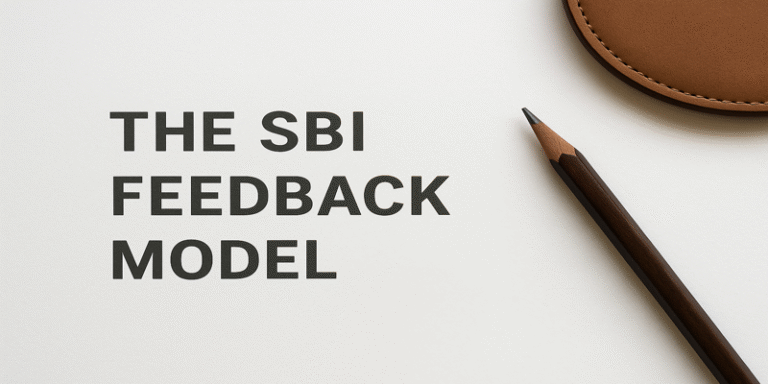Feedback plays a central role in organisational development, talent growth, and leadership effectiveness. Among the most widely adopted frameworks for feedback is the SBI feedback model, developed by the Centre for Creative Leadership (CCL), which stands for Situation, Behaviour, and Impact. The appeal of the model lies in its clarity, specificity, and actionability, enabling managers, educators, and leaders to give feedback in a constructive and impactful way (Kirkland & Manoogian, 1998).
This article explores the structure of the SBI feedback model, its advantages and criticisms, and its role in enhancing communication, learning, and talent development within organisations.
1.0 Structure of the SBI Model
1.1 Situation
The first stage involves describing the specific situation in which the observed behaviour occurred. Context-setting avoids generalisation and provides the receiver with a clear understanding of the circumstances. For instance: “During yesterday’s project update meeting when timelines were being discussed…”. By grounding feedback in time and place, ambiguity is reduced (Bungay Stanier, 2010).
1.2 Behaviour
Next, the observable behaviour is described factually. This ensures feedback is objective and non-judgemental. For example: “…you interrupted two colleagues before they could finish their points…”. Avoiding assumptions about motives (e.g., “you were being disrespectful”) helps maintain psychological safety and increases the likelihood of constructive dialogue (Harrelson, 2024).
1.3 Impact
Finally, the impact of the behaviour is articulated, focusing on consequences for the team, project, or organisation. For example: “…this made it difficult for others to share updates and some felt undervalued.” Research suggests that explaining impact helps recipients understand why their actions matter, fostering accountability and reflection (Stone & Heen, 2014).
By using this structured flow, the SBI model transforms vague feedback into a clear and actionable message.
2.0 Advantages of the SBI Model
The SBI framework is valued for several reasons:
- Clarity and specificity: It provides a structured approach that reduces the risk of ambiguous or vague feedback (Turregano & Gaffney, 2012).
- Depersonalisation: By focusing on situations and behaviours rather than character traits, it minimises the perception of feedback as a personal attack (Daaleman et al., 2021).
- Encourages reflection: Recipients gain insight into the real-world consequences of their behaviour, which supports behavioural change (Carman, 2015).
- Universality: The model is used across industries, including corporate, healthcare, education, and nonprofit sectors, illustrating its broad applicability (Lee et al., 2021).
- Supports growth cultures: When embedded in performance management, SBI feedback strengthens a culture of continuous learning and development (Fleenor, Taylor & Chappelow, 2020).
3.0 Criticisms and Limitations
While widely endorsed, the SBI method is not without limitations.
- Over-simplification: Some critics argue that the model’s structure may be too formulaic, neglecting complex relational dynamics in feedback conversations (Jelley, 2021).
- Risk of rigidity: Leaders may apply it mechanically, creating a “checklist” approach rather than engaging in genuine dialogue (Beenen, 2021).
- Emotional blind spots: The model emphasises observable behaviour but may downplay emotional intelligence aspects, such as tone, empathy, and relational context (Aguinis & Kraiger, 2009).
- Cultural considerations: In collectivist cultures, direct feedback—even when structured—may still be perceived as confrontational, highlighting the need for cultural adaptation (Carman, 2015).
These limitations suggest that SBI should be used as a foundation for dialogue rather than a strict formula.
4.0 SBI and Talent Growth in Organisations
The relevance of the SBI model extends to talent development and organisational growth.
4.1 Enhancing Leadership Development
Leadership training programmes often integrate SBI as a tool to improve communication, accountability, and coaching effectiveness (Harrison, 2010). Leaders who master SBI provide feedback that is balanced and actionable, supporting emerging leaders in developing self-awareness.
4.2 Performance Appraisal and Coaching
SBI is also applied in performance appraisal systems. Rather than vague appraisals such as “good teamwork,” managers can highlight specific incidents of collaboration and describe their positive outcomes, reinforcing desirable behaviours (Wasankar, 2023).
4.3 Creating a Learning Culture
The model aligns with learning organisation principles by encouraging continuous dialogue about behaviour and outcomes. This not only supports individual learning but also contributes to organisational knowledge-sharing and collective improvement (Turregano & Gaffney, 2012).
4.4 Application in Healthcare and Education
In medical education, the model (and its extension SBIA – Situation, Behaviour, Impact, Action) has been shown to help students receive constructive feedback on clinical skills in ways that enhance reflection and improvement (Lee et al., 2021). Similarly, in higher education, it assists lecturers in giving students specific, actionable academic feedback (Daaleman et al., 2021).
5.0 Example of SBI in Action
A real-world example demonstrates the model’s effectiveness:
- Situation: “During last Friday’s client presentation…”
- Behaviour: “…you continued to read directly from the slides without engaging with the audience.”
- Impact: “…the client appeared disengaged, and we risked undermining the team’s credibility.”
This structured delivery ensures the employee understands the context, the behaviour, and its consequences, while avoiding accusations.
The SBI feedback model remains one of the most effective and practical frameworks for enhancing talent growth and fostering constructive communication within organisations. Its structured approach allows managers, educators, and leaders to provide feedback that is clear, specific, and actionable.
Although it has limitations—such as risks of rigidity and cultural mismatch—it continues to be highly valued across sectors. By promoting clarity, reflection, and accountability, SBI strengthens learning cultures and supports sustainable organisational development.
For organisations striving to nurture talent and encourage continuous improvement, the SBI model offers not just a framework for feedback, but a foundation for constructive dialogue, growth, and performance excellence.
References
Aguinis, H. & Kraiger, K. (2009). Benefits of training and development for individuals and teams, organisations, and society. Annual Review of Psychology, 60(1), 451–474.
Beenen, M. (2021). Supporting employee skill development from organisational culture perspective. Theseus.fi. [Available at: https://www.theseus.fi/handle/10024/427054]
Bungay Stanier, M. (2010). The Coaching Habit: Say Less, Ask More & Change the Way You Lead Forever. Toronto: Box of Crayons Press.
Carman, J.G. (2015). Feedback that works for nonprofit organisations. Journal of Nonprofit Education and Leadership, 5(1), 22–36.
Daaleman, T.P., Storrie, M., et al. (2021). Medical student leadership development through a business school partnership model. Journal of Leadership and Organisational Development, 42(3), 145–159.
Fleenor, J.W., Taylor, S. & Chappelow, C. (2020). Leveraging the Impact of 360-Degree Feedback. San Francisco: Jossey-Bass.
Harrelson, G.L. (2024). Improving personal effectiveness: Feedback models in practice. In Administrative Topics in Athletic Training. Routledge.
Harrison, S.D. (2010). Democratizing leader development. In Handbook of Leadership Development. San Francisco: Jossey-Bass.
Jelley, R.B. (2021). Using personality feedback for work-related development. Canadian Journal of Behavioural Science, 53(3), 201–210.
Kirkland, K. & Manoogian, S. (1998). Ongoing Feedback: How to Get It, How to Use It. Greensboro: Centre for Creative Leadership.
Lee, C.W., Chen, G.L., Yu, M.J., Cheng, P.L. (2021). A study to analyse narrative feedback records in medical education. Journal of Acute Medicine, 11(2), 1–7.
Stone, D. & Heen, S. (2014). Thanks for the Feedback: The Science and Art of Receiving Feedback Well. London: Penguin Books.
Turregano, C.G. & Gaffney, T.G. (2012). Creating a shared leadership culture through multilevel development. Public Manager, 41(2), 45–52.
Wasankar, V. (2023). Study of performance appraisal techniques with reference to SBI. Shikshamandal Journal of Management, 7(1), 85–94.









